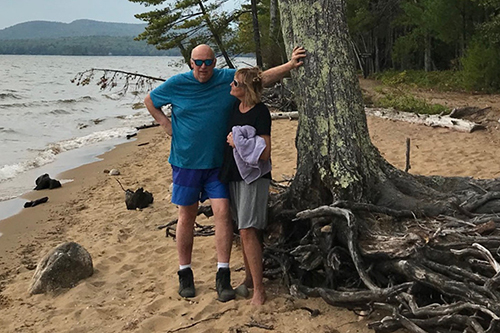 |
|||||||||||||||

Mega-Dams, Mega-Problems!
October 13, 2021
Roger Wheeler, President, Friends of Sebago LakeContact: Ed Friedman, 207-666-3372
Roger Wheeler retired in 2017 after a lifetime working in public education. His interests in the environment were nurtured from early experiences visiting Sebago Lake during summers of the 1960’s. Wheeler’s father was a geologist so every walk along his great, great aunt’s shoreline was a field trip where Roger developed his early appreciation for the powers of water, wind, and ice.
In the late 1980’s, the SD Warren Paper Company changed their flow management of Sebago Lake. The shoreline protecting beach quickly eroded away from the new longer duration of higher average lake levels throughout the summer and fall. Shoreline residents complained of resulting lake degradation.
What happened next for Wheeler has been a 30 plus year learning experience about lake, river, coastal environments and the politics of water control. Roger helped the organization, Friends of Sebago Lake (FOSL), participate in regulatory actions that advocated restoration of historic natural lake/river flow regimes that more mimicked the seasonal cycle and he succeeded Steve Kasprzak as President of Friends of Sebago Lake in 1998.
FOSL asked questions about the impacts of Sebago’s lake’s new altered flows on fisheries, water quality, lake wetlands, and beaches. The group assembled volumes of information as part of the evidence record in the FERC file for the Eel Weir project, 2984. The FOSL team searched archival records for and retrieved the firsthand accounts of anadromous fish such as salmon, shad, and alewives being present in the Sebago Lake watershed before Sebago Lake was dammed. This information was crucial in the unanimous decision of the US Supreme Court that required fish passage on Presumpscot River dams and other dams where these fish had been present. When FOSL began questioning impacts of the unnatural flow regulation on the riverine, estuarine, and coastal environments downstream from the now highly regulated Sebago Lake, Maine scientists and regulators were silent, oddly showed no interest, or were deflective in their statements.
Citing FOSL as being the sole concerned party, FERC refused to include impacts of flow regulation of coastal environments in Sebago Lake relicensing environmental impact statements. FOSL did not give up, and expanded their search. soon uncovering the works of Hans Neu, Michael Rozengurt and others who understood how dams can detrimentally affect the geosphere, atmosphere, hydrosphere, cryosphere and the biosphere and are altering our climate and devastating our marine fisheries. Wheeler assisted in the gathering of information for the books, Blue Deserts and Arctic Blue Deserts written by Steve Kasprzak and worked with a team including Friends of Merrymeeting Bay to hire a Canadian graduate student through the Quebec Labrador Foundation internship program to interview still living co-workers and descendants of Hans Neu and retrieve information not available on the internet. That effort was a stunning success.
Hydroelectric power, particularly involving the construction and operation of large or mega dams does not produce green energy. Building these monsters uses tons of fossil fuel creating plenty of greenhouse gases and then once built the large reservoirs or “blue deserts” continue discharging methane (and some CO2) for years as submerged vegetation decomposes. These blue deserts become relatively warmer bodies of water affecting local climate through their moderating meteorological effects. Impoundment flows tend to be released in the winter to make room for retaining spring snowmelt through dry summers. Natural flows however are highest in the spring freshet and this is when key nutrients like silica are flushed from the interior to the coast forming the nutrient menu for phytoplankton like diatoms, key primary producers for the entire marine food chain including commercial fisheries.
Relatively warm reservoir releases in winter however melt ice in their receiving waters, whether the Gulf of Maine, St. Lawrence River, James Bay, Hudson Bay or the Arctic Ocean. This decreases reflectivity or albedo, increasing oceanographic heat retention, greenhouse gas emissions, local climatic instability and larger scale climate warming. Because highest flows are now in winter, any nutrients delivered to the coast (those not impounded by the megadams), arrive at a useless time for the marine food chain, evolved to feed and grow primarily in response to the spring freshet.
Megadams also create the mega-problem of indigenous cultural genocide as valuable natural and cultural habitats are wiped out by rising waters and rivers no longer flow at all or possibly flow backwards. In Hydro Quebec territory the Inuit, Metis and Cree have all been adversely affected and displaced. The only thing green about hydro are the $100 dollar bills flying out of the turbines. Wheeler will explain all these effects providing little - seen Neu and Rozengurt research. For more information: Friends of Sebago Lake
Sarah Stapler
